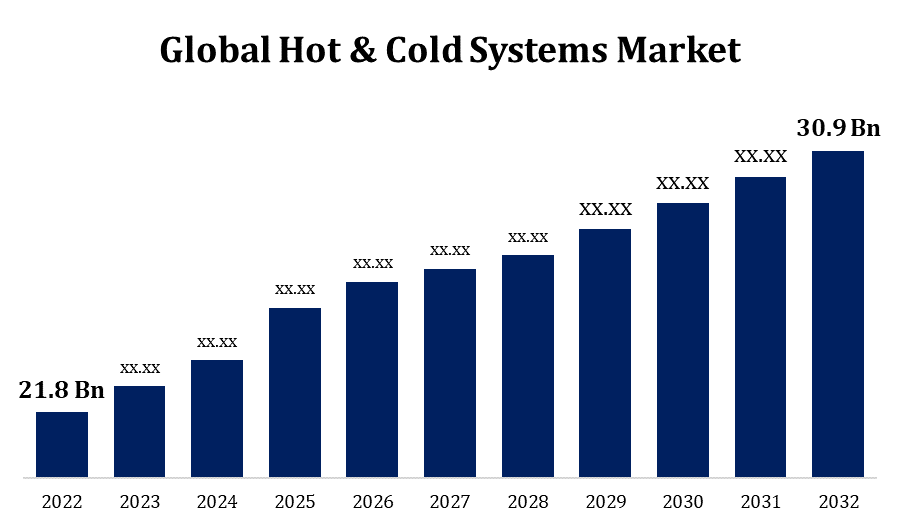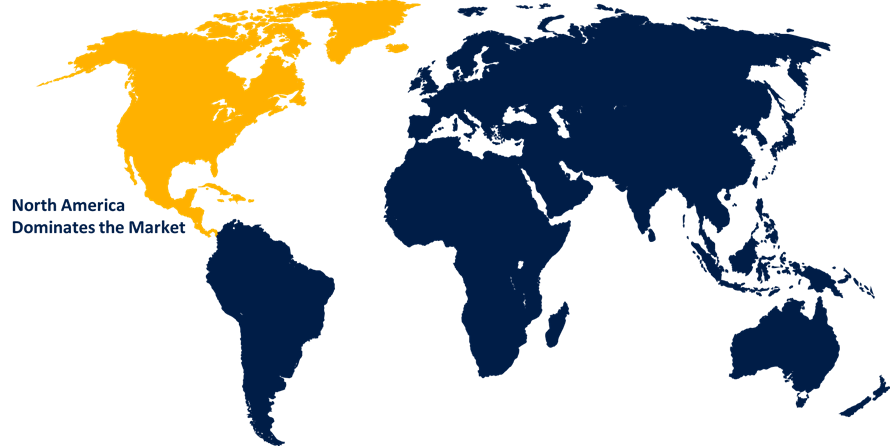Global Hot & Cold Systems Market Size To Worth USD 30.9 Billion By 2032 | CAGR of 3.5%
Category: Chemicals & MaterialsGlobal Hot & Cold Systems Market Size To Worth USD 30.9 Billion By 2032
According to a research report published by Spherical Insights & Consulting, the Global Hot & Cold Systems Market Size To Grow from USD 21.8 Billion in 2022 to USD 30.9 Billion by 2032, at a Compound Annual Growth Rate (CAGR) of 3.5% during the forecast period.

Get more details on this report -
Browse key industry insights spread across 200 pages with 110 Market data tables and figures & charts from the report on the "Global Hot & Cold Systems Market Size By Category (Heating, Cooling), By Application (Residential, Industrial, and Service), By Region, And Segment Forecasts, By Geographic Scope And Forecasts to 2032." Get Detailed Report Description Here: https://www.sphericalinsights.com/reports/hot-cold-systems-market
Heating systems include central heating, radiant heating, boilers, heat pumps, and electric heaters. In domestic, commercial, and industrial settings, it is commonly utilised for space heating, water heating, and industrial processes. Cooling systems include air conditioning, refrigeration, chillers, and evaporative cooling. Heating and cooling elements are combined in HVAC (heating, ventilation, and air conditioning) systems to give total climate control in buildings. Modern HVAC systems, which incorporate smart technologies, zoning, and renewable energy sources, frequently highlight energy efficiency. In addition to air conditioning, refrigeration systems are essential for storing and cooling food, pharmaceuticals, and other perishable commodities. Solar energy is growing more popular for heating and cooling, with solar water heaters and solar-powered air conditioning systems becoming increasingly popular.
Hot & Cold Systems Market Value Chain Analysis
Raw materials used in the manufacture of hot and cold systems include metals, polymers, insulating materials, and electrical components. Raw material suppliers supply the components required for the manufacture of heating and cooling systems. Companies that specialise in the production and assembly of heating and cooling systems provide the final goods. Technology providers contribute to the growth of current heating and cooling solutions. Improvements in energy efficiency, smart controls, and ecologically friendly materials are examples of this. Transportation and logistics companies play a key role in ensuring the timely and effective delivery of heating and cooling systems to a variety of markets. Homeowners, tenants, and people in residential settings are among those who utilise heating and cooling systems for comfort and climate management.
Hot & Cold Systems Market Opportunity Analysis
Manufacturers will have greater opportunities to design and market heating and cooling systems that consume less energy while providing optimal performance as the emphasis on energy efficiency develops. Customers benefit from increased control, automation, and energy savings in heating and cooling systems when smart technologies such as IoT (Internet of Things) and smart controls are included. The increasing use of renewable energy sources, notably solar, brings up opportunities for systems that integrate solar heating and cooling technologies, assisting in the achievement of sustainability goals. As a result of the rising demand for HVAC system retrofitting, businesses can provide solutions that update outdated heating and cooling systems to meet modern energy efficiency and environmental criteria.
Energy-efficient heating and cooling systems have the potential to save consumers and businesses money. More efficient systems can reduce utility costs over time. Smart technology, such as programmable thermostats and IoT-enabled devices, allows customers to regulate and control their heating and cooling systems, enhancing energy efficiency. Heating and cooling systems that use renewable energy sources, such as solar heating and geothermal systems, are in high demand because they provide long-term and cost-effective solutions. Because of urbanisation and population growth, new building development creates a demand for cutting-edge, energy-efficient heating and cooling systems. Consumers are becoming more appreciative of systems that not only regulate temperature but also improve indoor air quality, thereby addressing health and comfort concerns.
Purchase and installation of high-efficiency heating and cooling systems may be prohibitively expensive for some users, especially in residential and small business settings. Retrofitting existing buildings with energy-efficient technologies can be problematic due to the need for changes and compatibility issues with outdated systems. Some consumers may be uninformed of the benefits of energy-efficient technologies or may have misconceptions about their cost-effectiveness, hindering market adoption. Because the sector is dependent on a global supply chain, it is prone to disruptions such as resource shortages, transportation issues, and geopolitical crises. Certain customers and businesses may prioritise short-term costs over long-term savings, perhaps neglecting the economic benefits of energy-efficient equipment.
Insights by Category
The heating segment accounted for the largest market share over the forecast period 2023 to 2032. The heating segment faces increased demand throughout the colder seasons, particularly in regions with different winter climates. Residential, commercial, and industrial users require efficient heating solutions for comfort and productivity. Consumers and businesses are becoming more aware of the need of energy efficiency, pushing them to invest in high-efficiency heating systems that provide both economic savings and a lower environmental impact. Manufacturing, chemicals, and food processing all rely on efficient heating solutions. Advanced industrial heaters aid in increasing output while conserving energy.
Insights by Application
The residential segment accounted for the largest market share over the forecast period 2023 to 2032. Construction of new residential structures and housing projects creates opportunities for modern heating and cooling systems to be implemented in newly developed areas. Homeowners are becoming more aware of energy efficiency, which is boosting demand for heating and cooling systems that provide both financial savings and a lower environmental impact. Smart home technology, such as smart thermostats and HVAC controllers, improves the user experience and allows homeowners to handle their heating and cooling systems remotely. Residential air conditioning is in high demand, particularly in hot climates, as homeowners seek effective cooling solutions for their living areas.
Insights by Region

Get more details on this report -
North America is anticipated to dominate the Hot & Cold Systems Market from 2023 to 2032. North America is an important market for heating and cooling systems due to its large and diverse population, significant urbanisation, and ongoing building projects. North America is a technological powerhouse in HVAC (Heating, Ventilation, and Air Conditioning). Continuous R&D helps to bring new, more energy-efficient technology to market. North America has implemented stringent energy efficiency laws, influencing the design and construction of heating and cooling systems to meet or exceed these standards. The use of renewable energy sources, such as solar heating and geothermal systems, is in keeping with the region's focus on sustainability and carbon reduction.
Asia Pacific is witnessing the fastest market growth between 2023 to 2032. Heating and cooling systems have a substantial and rapidly developing market in Asia-Pacific. Demand is being driven by the region's population growth, urbanisation, and increased infrastructure development. Asia-Pacific, being a major manufacturing hub, has a high need for industrial heating and cooling systems. These systems are essential in industries such as automotive, electronics, and chemicals. The Asia-Pacific region quickly absorbs new technologies. Smart technologies and energy-saving solutions must be integrated into heating and cooling systems.
Recent Market Developments
- In August 2021, the Canadian government granted a US$165,000 grant to InukshukSynergie through the Department of Natural Resources Canada to help them commercialise biomass-based heating systems.
Competitive Landscape
Major players in the market
- Johnson Controls
- Siemens
- Daikin
- Lennox International
- Trane
- Rheem Manufacturing
- Engie
- Mitsubishi Electric
- Haier
- Danfoss
- Empower
- Veolia
- Goodman
- Fortum
Market Segmentation
This study forecasts revenue at global, regional, and country levels from 2023 to 2032.
Hot & Cold Systems Market, Category Analysis
- Heating
- Cooling
Hot & Cold Systems Market, Application Analysis
- Residential
- Industrial
- Service
Hot & Cold Systems Market, Regional Analysis
- North America
- US
- Canada
- Mexico
- Europe
- Germany
- Uk
- France
- Italy
- Spain
- Russia
- Rest of Europe
- Asia Pacific
- China
- Japan
- India
- South Korea
- Australia
- South America
- Brazil
- Argentina
- Colombia
- Middle East & Africa
- UAE
- Saudi Arabia
- South Africa
About the Spherical Insights & Consulting
Spherical Insights & Consulting is a market research and consulting firm which provides actionable market research study, quantitative forecasting and trends analysis provides forward-looking insight especially designed for decision makers and aids ROI.
Which is catering to different industry such as financial sectors, industrial sectors, government organizations, universities, non-profits and corporations. The company's mission is to work with businesses to achieve business objectives and maintain strategic improvements.
CONTACT US:
For More Information on Your Target Market, Please Contact Us Below:
Phone: +1 303 800 4326 (the U.S.)
Phone: +91 90289 24100 (APAC)
Email: inquiry@sphericalinsights.com, sales@sphericalinsights.com
Contact Us: https://www.sphericalinsights.com/contact-us
Need help to buy this report?